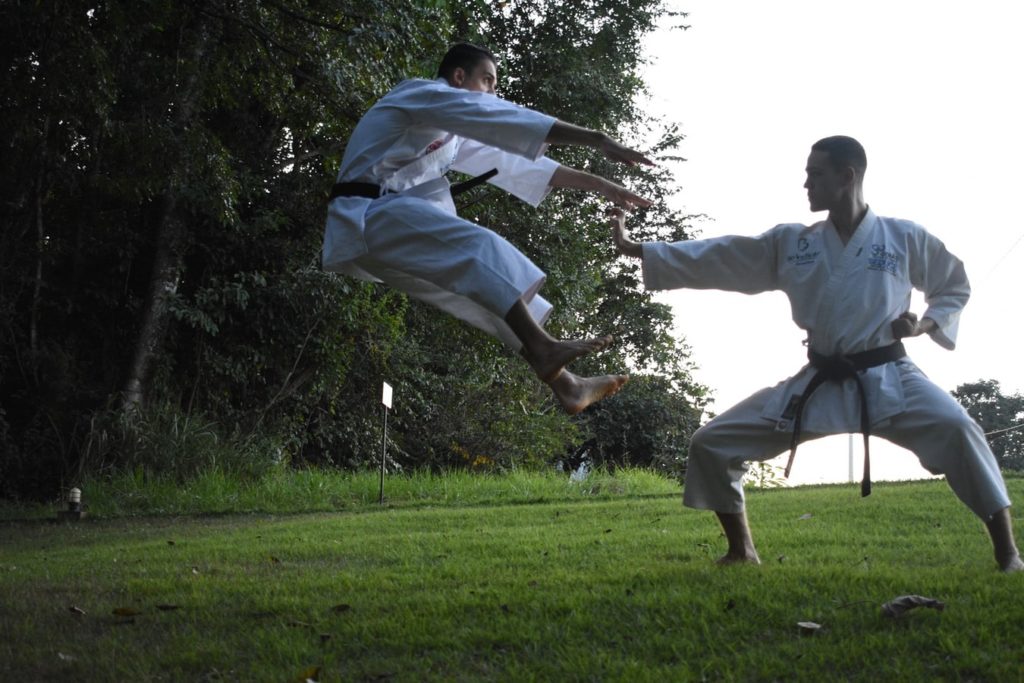Taekwondo goes back 2,300 years to its development as a martial art in Korea, where the word “Tae” means foot, “Kwon” means fist and “Do” means “way of.” So Taekwondo translates as “the way of the foot and fist.”

Teaching Taekwondo is both professionally rewarding and a good way to make a nice income while staying in peak physical condition.
You’ll be able to attract students from all walks of life as well as age. Taekwondo is practiced by children, teens, adults and seniors. Ready to get moving? Read on to discover how you can become a Taekwondo instructor.
In this article you’ll learn:
- How much money you can make as a Taekwondo instructor
- The required training and certifications
- Professional groups to join
- Employment opportunities for Taekwondo instructors
- Finding clients
- Plus helpful tips
How much money can you make?
The average national salary for a Taekwondo instructor is $32,079 per year, according to a recent ZipRecruiter survey. Some instructors reported annual salaries as high as $49,000. These are individuals who work for a Taekwondo studio. Operating your own studio opens the opportunity to make more money, but you’ll also be responsible for marketing to recruit and retain students, as well as all the expenses that come with running a business.

Training and Certification
There is no specific license required to operate a Taekwondo school in the United States. You do need liability insurance to protect yourself and your students in case of an injury or other accident. To be credible as an instructor and to attract students, earning certification as a Taekwondo instructor is crucial to your success. Certification will help you get a job teaching this martial art. Certification promoted on your website and marketing materials shows prospective students that spending time and money at your school will be a good investment.
There are numerous online and in-person instructor training programs to choose from. It’s important to pick a program that includes certification recognized throughout the country. If in doubt, contact the program and ask.
The American Taekwondo Association is one of the oldest and leading US organizations devoted to the martial art, and offers training leading to certification for instructors. Black belts spend 2-3 years as instructor trainees. During this time they teach at least 300 hours under the supervision of a senior instructor. They are also required to earn certification in CPR and Youth Protection, and to attend instruction camps.

Some of what you’ll learn in training:
- How to teach the fundamental moves and spiritual underpinnings of Taekwondo
- Create lesson plans and a course curriculum
- How to teach students at different ages and skill levels
- Develop leadership skills
- How to organize competitions and tournaments
- Basic business skills relevant to running a Taekwondo dojang (training hall)
Professional Groups to Join
Show students and prospective employers that you are serious about your career by joining a professional association devoted to Taekwondo. Benefits of getting involved with a professional group include networking with other members (who can offer job tips), access to continuing education and training, competitions and being part of a group that shares your passion.
The American Taekwondo Association helps members advance their careers and open their own ATA branded Taekwondo schools – or find employment at one of these schools. Founded in 1969, the association now counts 900 independently owned and operated licensed facilities worldwide.

The United States Taekwondo Association promotes excellence in the learning, practice, and teaching of traditional taekwondo. The association helps organize curricula for accredited schools and assists instructors in planning and implementing their programs effectively. The association also maintains a National Registry of individual and group members at its headquarters in Warwick, New York. Annual membership is $30.
The US National Taekwondo Association is the first and still the only Taekwondo organization to develop an American link to the traditional Taekwondo organizations in Korea. They provide both National and also International Taekwondo certification to members.
USA Taekwondo is a non-profit organization that relies on the support of members and donors along with United States Olympic Committee funding to meet its goal of improving standards in Taekwondo throughout the country, as well as development and support of athletes competing in the sport at elite and up and coming levels. A coach membership is $50 a year and includes these benefits:
- Sport Accident Insurance (secondary medical)
- Online registration for membership and events
- Referee, coaching and sports medicine seminars
- Discounts on travel and accommodations
- USATKD online membership profile
- USATKD membership card.
Employment
Look for job opportunities for Taekwondo instructors at martial arts studios, public recreation centers, the YMCA, larger gyms with fitness programs and fitness centers focused on martial arts programs for children and teens.

You’ll want to make copies of your resume, both printed and for online distribution. When sending resumes by email, the best way to attach this document and supporting materials is by creating .pdf files of the documents with Adobe Acrobat. These types of files are considered safe to send and are less likely to trigger a spam alert in the recipient’s mailbox. Follow this tip and you’ll have a much better chance that your online correspondence lands in front of a real person, not a spam folder.
Also make photocopies of your professional certifications and memberships in Taekwondo organizations and clubs. These extra materials can pull your application to the top of the pile and set you apart from competitors for the same job.
Finding Clients
An attractively designed website and business cards should be the core of your marketing toolkit as a Taekwondo instructor. The website can be as fancy as you like, so long as it looks professional, with photos of your Taekwondo studio, students practicing their moves and a few images of you in action, teaching students. Your business location and contact information should be clearly visible at the top of every page on your website. Search engines scan this information to match your website geographically with people searching for a Taekwondo instructor.

In addition to your business website, the next thing to do is create an Instagram account to showcase your Taekwondo studio. Instagram is the #1 online venue for professionals to promote their work. It’s a free marketing tool that’s always working on your behalf.
Now set up a Facebook page for your Taekwondo school. This is a great way to build a following and keep people up-to-date on your offerings.
Be sure to create a Google My Business page, where you can add hours of operation, photos and an interactive map of your location.
All of the above services are free. It shouldn’t take more than an hour to set up a page on each site, including photo uploads.
Other strategies for attracting new business:
- Create a referral program with discounts for returning Taekwondo students who bring new people to class.
- Ask students to review your Taekwondo program online. According to a recent survey, 90% of people say their buying decisions are influenced by positive online reviews.
Good to know
Some Taekwondo teaching tips for new instructors from trainers with years of experience:
Use the Praise-Improve-Praise Method
This is a way to offer positive critiques for correcting technique or form. Start with praise, describe the improvement and finish with more praise. For example, “That was a great kick! Now you want to adjust your foot this way and ….”

Group Students by Ability
Organize students into groups based on their actual skill level, not age or athleticism. For instance, group all the Blue Belts together for practice regardless of age.
Understand Student Goals
Whether a student wants to learn self-defense, compete in events or improve overall physical conditioning, not everyone is in class for the same reason.
Picture the Outcome
During challenging sessions, when some students may become frustrated or something just isn’t working, take time to pause and encourage everyone to visualize the outcome of what they are trying to accomplish. When we picture a goal in our minds, when we see the potential reward, it creates the motivation to press on and keep working.
Inch-Stones
This is a way of offering more frequent recognition than honoring Milestones, which are greater achievements but occur less frequently. Praising Inch-Stones helps students feel they are constantly making progress.
Don’t Wear out Your Classes
Be mindful of the fact that, as a Taekwondo instructor, you are a professional athlete and your endurance is likely to far outlast anyone in the class. Remember, injuries and accidents tend to occur more often when we are tired.
If you enjoyed this article, check out some more great PocketSuite.io content that can help you grow your career as a Taekwondo instructor. Here’s a great place to start.PocketSuite has thousands of business owners who all started where you are right now. Our community is always happy to help you ramp up, grow your client base, and achieve your income goals, both within the PocketSuite app and as part of our exclusive Facebook Community Group. PocketSuite’s vision is for any professional to be able to work for themselves and make a great living. It starts here. It starts with you. It starts today. Let’s get started, download PocketSuite now! Feel free to reach out with any questions (we’d love to hear from you)! Text us @ (415) 841-2300.



